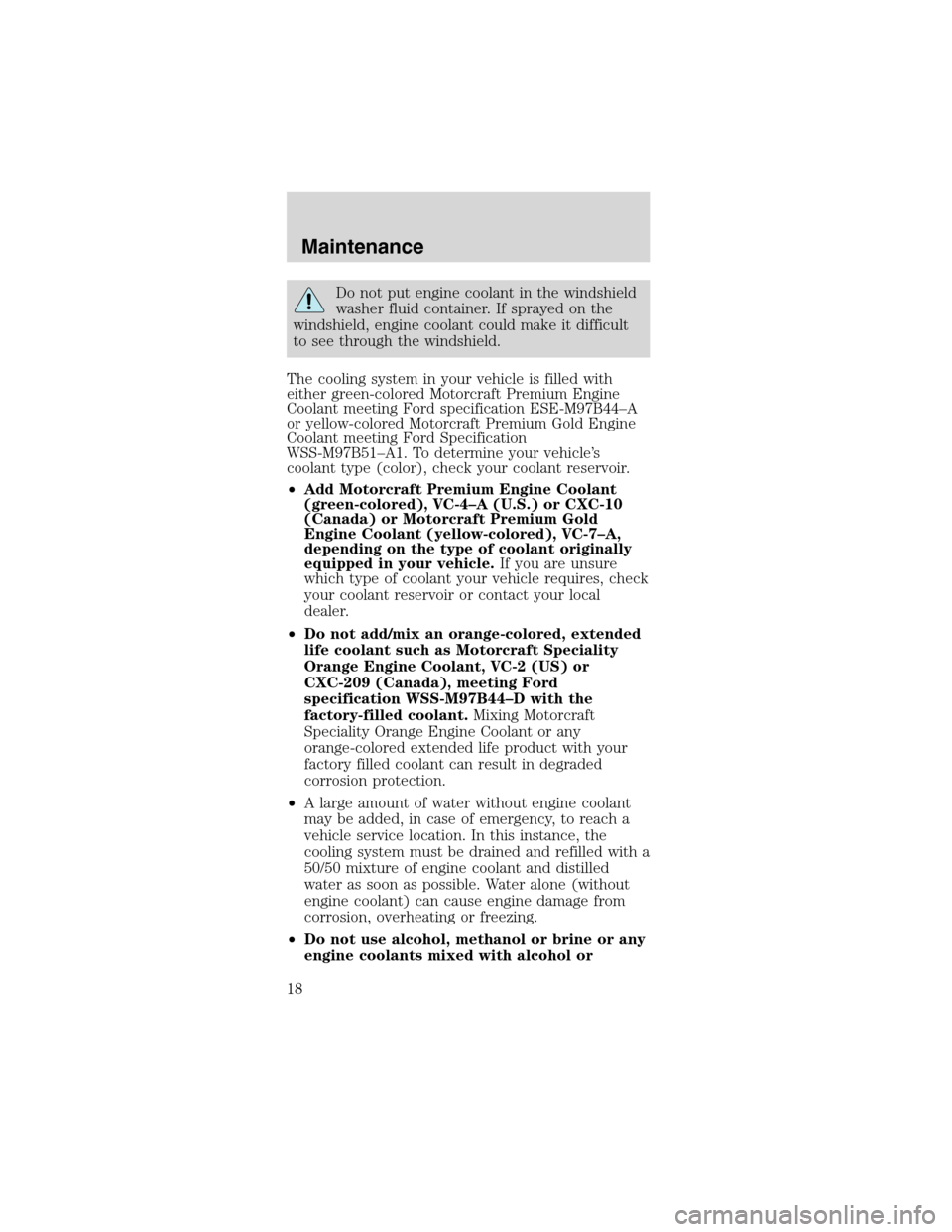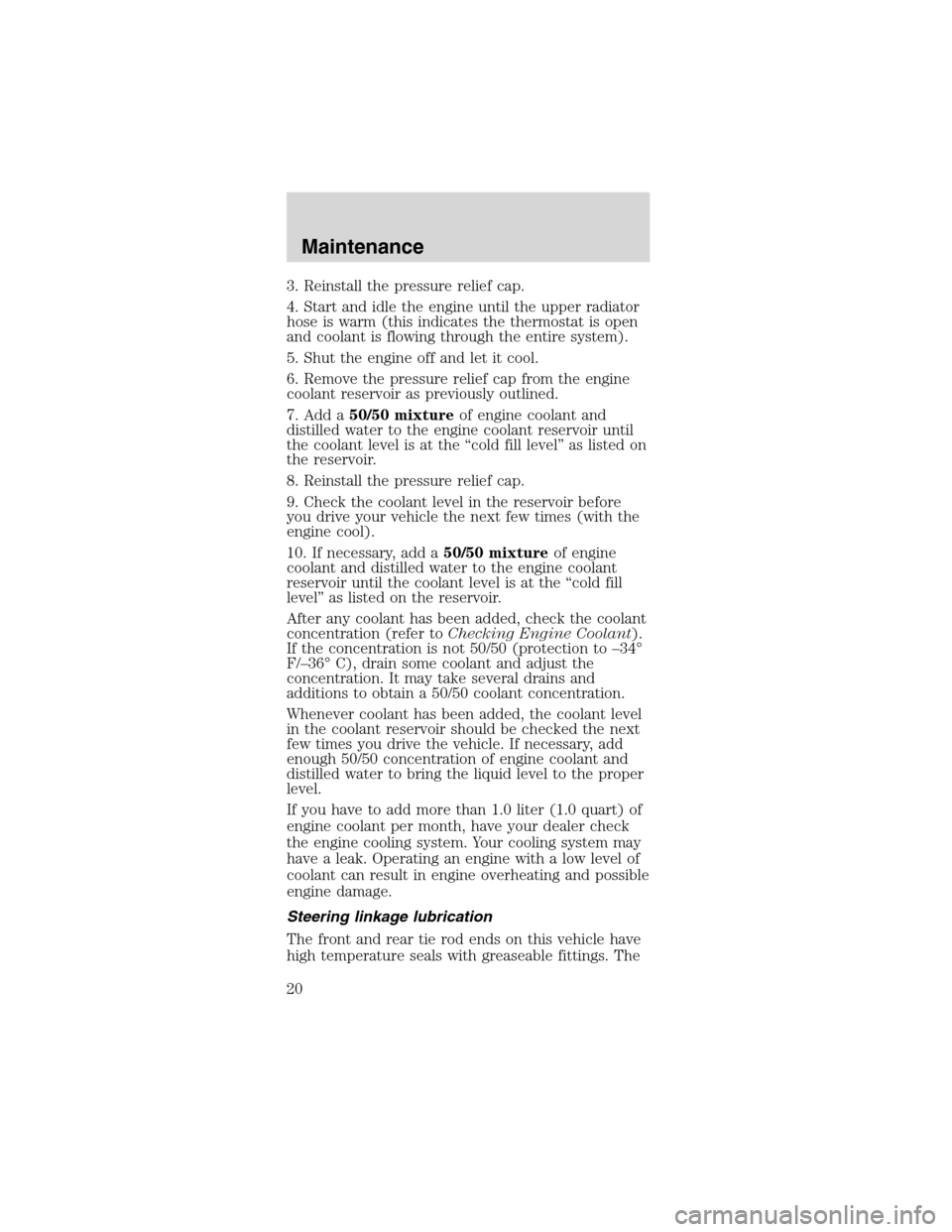Page 17 of 32

•an accurate temperature readout from the
engine coolant gauge.
When the engine is cold,
check the level of the
engine coolant in the
reservoir.
•The engine coolant should be at the“cold fill
level”as listed on the engine coolant reservoir.
•Refer to the scheduled maintenance guide for
service interval schedules.
•Be sure to read and understandPrecautions
when servicing your vehiclein this chapter.
If the engine coolant has not been checked at the
recommended interval, the engine coolant reservoir
may become low or empty. If the reservoir is low or
empty, add engine coolant to the reservoir. Refer to
Adding engine coolantin this chapter.
Note:Automotive fluids are not interchangeable; do
not use engine coolant, antifreeze or windshield
washer fluid outside of its specified function and
vehicle location.
Adding engine coolant
When adding coolant, make sure it is a 50/50
mixture of engine coolant and distilled water. Add
the mixture to the coolant reservoir,when the
engine is cool, until the appropriate fill level is
obtained.
Do not add engine coolant when the engine
is hot. Steam and scalding liquids released
from a hot cooling system can burn you badly.
Also, you can be burned if you spill coolant on hot
engine parts.
Maintenance
17
Page 18 of 32

Do not put engine coolant in the windshield
washer fluid container. If sprayed on the
windshield, engine coolant could make it difficult
to see through the windshield.
The cooling system in your vehicle is filled with
either green-colored Motorcraft Premium Engine
Coolant meeting Ford specification ESE-M97B44–A
or yellow-colored Motorcraft Premium Gold Engine
Coolant meeting Ford Specification
WSS-M97B51–A1. To determine your vehicle’s
coolant type (color), check your coolant reservoir.
•Add Motorcraft Premium Engine Coolant
(green-colored), VC-4–A (U.S.) or CXC-10
(Canada) or Motorcraft Premium Gold
Engine Coolant (yellow-colored), VC-7–A,
depending on the type of coolant originally
equipped in your vehicle.If you are unsure
which type of coolant your vehicle requires, check
your coolant reservoir or contact your local
dealer.
•Do not add/mix an orange-colored, extended
life coolant such as Motorcraft Speciality
Orange Engine Coolant, VC-2 (US) or
CXC-209 (Canada), meeting Ford
specification WSS-M97B44–D with the
factory-filled coolant.Mixing Motorcraft
Speciality Orange Engine Coolant or any
orange-colored extended life product with your
factory filled coolant can result in degraded
corrosion protection.
•A large amount of water without engine coolant
may be added, in case of emergency, to reach a
vehicle service location. In this instance, the
cooling system must be drained and refilled with a
50/50 mixture of engine coolant and distilled
water as soon as possible. Water alone (without
engine coolant) can cause engine damage from
corrosion, overheating or freezing.
•Do not use alcohol, methanol or brine or any
engine coolants mixed with alcohol or
Maintenance
18
Page 19 of 32

methanol antifreeze (coolant).Alcohol and
other liquids can cause engine damage from
overheating or freezing.
•Do not add extra inhibitors or additives to
the coolant.These can be harmful and
compromise the corrosion protection of the
engine coolant.
•Do not mix with recycled coolant unless from
a Ford-approved recycling process (seeUse of
Recycled Engine Coolantsection).
To avoid personal injury, make sure the
engine is cool before unscrewing the coolant
pressure relief cap. The cooling system is under
pressure; steam and hot liquid can come out
forcefully when the cap is loosened slightly.
If you must remove the pressure relief cap or
radiator cap (depending upon engine application),
follow these steps to avoid personal injury:
1. Before you remove the cap, turn the engine off
and let it cool.
2. When the engine is cool, wrap a thick cloth
around the cap. Slowly turn cap counterclockwise
until pressure begins to release.
3. Step back while the pressure releases.
4. When you are sure that all the pressure has been
released, use the cloth to turn it counterclockwise
and remove the cap.
Engine coolant refill procedure
The following procedure should be used when
refilling the cooling system after it has been drained
or become extremely low.
1. Remove the pressure relief cap from the engine
coolant reservoir as previously outlined.
2. Slowly add a50/50 mixtureof engine coolant
and distilled water to the engine coolant reservoir
until the coolant level is at the“cold fill level”as
listed on the reservoir.
Maintenance
19
Page 20 of 32

3. Reinstall the pressure relief cap.
4. Start and idle the engine until the upper radiator
hose is warm (this indicates the thermostat is open
and coolant is flowing through the entire system).
5. Shut the engine off and let it cool.
6. Remove the pressure relief cap from the engine
coolant reservoir as previously outlined.
7. Add a50/50 mixtureof engine coolant and
distilled water to the engine coolant reservoir until
the coolant level is at the“cold fill level”as listed on
the reservoir.
8. Reinstall the pressure relief cap.
9. Check the coolant level in the reservoir before
you drive your vehicle the next few times (with the
engine cool).
10. If necessary, add a50/50 mixtureof engine
coolant and distilled water to the engine coolant
reservoir until the coolant level is at the“cold fill
level”as listed on the reservoir.
After any coolant has been added, check the coolant
concentration (refer toChecking Engine Coolant).
If the concentration is not 50/50 (protection to–34°
F/–36°C), drain some coolant and adjust the
concentration. It may take several drains and
additions to obtain a 50/50 coolant concentration.
Whenever coolant has been added, the coolant level
in the coolant reservoir should be checked the next
few times you drive the vehicle. If necessary, add
enough 50/50 concentration of engine coolant and
distilled water to bring the liquid level to the proper
level.
If you have to add more than 1.0 liter (1.0 quart) of
engine coolant per month, have your dealer check
the engine cooling system. Your cooling system may
have a leak. Operating an engine with a low level of
coolant can result in engine overheating and possible
engine damage.
Steering linkage lubrication
The front and rear tie rod ends on this vehicle have
high temperature seals with greaseable fittings. The
Maintenance
20
Page 21 of 32
fittings must be lubricated at regular maintenance
intervals as indicated in the Scheduled Maintenance
Guide using Ford recommended ESA M1C 92A
grease to ensure proper function and extended
service life.
•location of the front
tie rod
•location of the rear tie
rod
USING THE RIGHT BULBS
Function Trade Number
Luggage compartment lamp S211
High-mount brake lamp (Service as
complete assembly)See your Dealer
Fog lamp 9145
WINTER DRIVING
For winter driving, it is recommended to install
radial winter tires.
Winter tires are designed to improve traction in
adverse winter weather conditions.
Note:Use of tire cable/chains are restricted on this
vehicle due to the potential damage to body and/or
suspension components.
Maintenance
21
Page 22 of 32

When installing winter tires:
•Only radial ply winter tires may be installed.
•For a recommended wheel and tire package, ask
your SVT dealer or call the SVT Info. Center at
(800) FORD-SVT.
•Winter tires of the same size and type must be
mounted on all four wheel positions.
•Winter tires must have the same load capacity as
the vehicle’s original equipment tires.
Do not exceed 75 miles per hour in a
vehicle equipped with winter tires.
Winter tires available for your vehicle will
likely have a maximum speed rating which is
less than the maximum speed of your vehicle.
Driving faster than the maximum speed for which
tires are rated and approved may lead to sudden
tire failure. This can cause loss of vehicle control
and lead to an accident and personal injury.
Adjust your driving and speed to prevailing
road and traffic conditions.
Observe the specified tire inflation
pressures.
Have the wheel and tire assemblies balanced
every time the tires are dismounted.
The use of snow cables or chains on the
vehicle (vehicle specific tire size) tire is not
recommended for this vehicle, as damage to your
vehicle may occur.
Maintenance
22
Page 23 of 32

WRECKER TOWING
If you need to have your vehicle towed, contact a
professional towing service or, if you are a member,
your roadside assistance center.
It is recommended that your vehicle be towed only
with flatbed equipment and that 4x4 blocks must be
used when loading/unloading your vehicle. Do not tow
with a wheel lift or a slingbelt. Ford Motor Company
has not approved a slingbelt towing procedure.
If the vehicle is towed by other means or
incorrectly, vehicle damage may occur.
Ford Motor Company produces a towing manual for
all authorized tow truck operators. Have your tow
truck operator refer to this manual for proper
hook-up and towing procedures for your vehicle.
Auxiliary power distribution block
Cobra vehicles have an auxiliary power distribution
block that is located by the air cleaner assembly.
Fuse Amp RatingPower Distribution Box Description
30A CB High-speed fan
Full ISO Relay Intercooler Pump
Please refer to your owner’s guide for complete
fusing information.
Roadside Emergencies
23
Page 24 of 32

A WORD ABOUT WARRANTY COVERAGE
The SVT Mustang Cobra carries the same New
Vehicle Limited Warranty as other Ford Mustang
models. This information is covered in its entirety in
the Ford Motor Company Warranty Guide.
Warranty service for the SVT Mustang Cobra or any
SVT vehicle can be obtained at any Ford Lincoln
Mercury dealer nationwide.
SVT does not recommend modifying or racing SVT
vehicles, as they are designed and built to be driven
as delivered from the factory. The Ford Motor
Company Warranty Guide discusses vehicle usage
and the installation of aftermarket parts and their
effect on warranty coverage as follows:
Repairs are not reimbursable under warranty when
damage is caused by:
•misusing the vehicle, such as driving over curbs,
overloading, racing, or using the vehicle as a
stationary power source.
•altering or modifying the vehicle—including the
body, chassis, or components—after the vehicle
leaves Ford’s control.
•non-Ford parts installed after the vehicle leaves
Ford’s control, including, but not limited to,
cellular phones, alarm systems, and automatic
starting systems.
Please see the Warranty guide for complete
information.
A word about warranty coverage
24